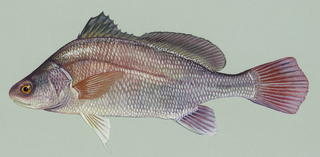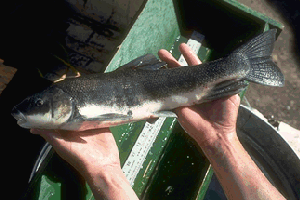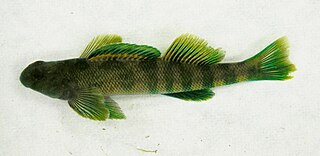
The quillback, also known as the quillback carpsucker, is a type of freshwater fish of the sucker family widely distributed throughout North America. It is deeper-bodied than most suckers, leading to a carplike appearance. It can be distinguished from carp by the lack of barbels around the mouth. The quillback is long-lived, with age beyond 50 years documented.

The Percidae are a family of ray-finned fish, part of the order Perciformes, which are found in fresh and brackish waters of the Northern Hemisphere. The majority are Nearctic, but there are also Palearctic species. The family contains more than 200 species in 11 genera. The perches, and their relatives are in this family; well-known species include the walleye, sauger, ruffe, and three species of perch. However, small fish known as darters are also a part of this family.
The Amiiformes order of fish has only one extant species, the bowfin. These Amiiformes are found in the freshwater systems throughout North America and parts of southern Canada. They live in freshwater streams, rivers, and swamps. These bowfin fish are not on the endangered list. They have the ability to go to the surface to breathe if the water level is too low. The extinct species of the Amiiformes can be found fossilized in Asia and Europe, but the bowfin is the last living species in the order.
Ophidiiformes is an order of ray-finned fish that includes the cusk-eels, pearlfishes, viviparous brotulas, and others. Members of this order have small heads and long slender bodies. They have either smooth scales or no scales, a long dorsal fin and an anal fin that typically runs into the caudal fin. They mostly come from the tropics and subtropics, and live in both freshwater and marine habitats, including abyssal depths. They have adopted a range of feeding methods and lifestyles, including parasitism. The majority are egg-laying, but some are viviparous.

Gars are members of the Lepisosteiformes, an ancient holosteian order of ray-finned fish; fossils from this order are known from the Late Jurassic onwards. The family Lepisosteidae includes seven living species of fish in two genera that inhabit fresh, brackish, and occasionally marine, waters of eastern North America, Central America and the Caribbean islands. Gars have elongated bodies that are heavily armored with ganoid scales, and fronted by similarly elongated jaws filled with long, sharp teeth. Gars are sometimes referred to as "garpike", but are not closely related to pike, which are in the fish family Esocidae. All of the gars are relatively large fish, but the alligator gar is the largest – the alligator gar often grows to a length of over 2 m (6.5 ft) and a weight of over 45 kg (100 lb), and specimens of up to 3 m (9.8 ft) in length have been reported. Unusually, their vascularised swim bladders can function as lungs, and most gars surface periodically to take a gulp of air. Gar flesh is edible and the hard skin and scales of gars are used by humans, but gar eggs are highly toxic.

Combtooth blennies are blenniiformids; percomorph marine fish of the family Blenniidae, part of the order Blenniiformes. They are the largest family of blennies with around 401 known species in 58 generas. Combtooth blennies are found in tropical and subtropical waters in the Atlantic, Pacific and Indian Oceans; some species are also found in brackish and even freshwater environments.

The bluegill is a species of freshwater fish sometimes referred to as "bream", "brim", "sunny", or "copper nose". It is a member of the sunfish family Centrarchidae of the order Perciformes. It is native to North America and lives in streams, rivers, lakes, and ponds. It is commonly found east of the Rockies. It usually hides around and inside old tree stumps and other underwater structures. It can live in either deep or very shallow water, and will often move from one to the other depending on the time of day or season. Bluegills also like to find shelter among aquatic plants and in the shade of trees along banks.

The freshwater drum, Aplodinotus grunniens, is a fish endemic to North and Central America. It is the only species in the genus Aplodinotus, and is a member of the family Sciaenidae. It is the only North American member of the group that inhabits freshwater for its entire life. Its generic name, Aplodinotus, comes from Greek meaning "single back", and the specific epithet, grunniens, comes from a Latin word meaning "grunting". It is given to it because of the grunting noise that mature males make. This noise comes from a special set of muscles within the body cavity that vibrate against the swim bladder. The purpose of the grunting is unknown, but due to it being present in only mature males and during the spawning season, it is assumed to be linked to spawning.

Pimephales, commonly known as the bluntnose minnows, is a genus of cyprinid fish found in North America. All of the four species are small fish, with P. notatus being the largest at 11 cm. These minnows can be found all over North America and are commonly used as fish bait.

Chasmistes is a genus of ray-finned fish in the family Catostomidae.

Moxostoma, the redhorses or jumprocks, is a genus of North American ray-finned fish in the family Catostomidae.

Madtoms are freshwater catfishes of the genus Noturus of the family Ictaluridae. It is the most species-rich family of catfish in North America, native to the central and eastern United States, and adjacent parts of Canada. Their fin spines contain a mild venom with a sting comparable to that of a honey bee.

The Catostomidae are the suckers of the order Cypriniformes, with about 78 species in this family of freshwater fishes. The Catostomidae are almost exclusively native to North America. The only exceptions are Catostomus catostomus, found in both North America and Russia, and Myxocyprinus asiaticus found only in China. In the Ozarks they are a common food fish and a festival is held each year to celebrate them. Ictiobus cyprinellus can reach an age up to 112 years, making it the oldest known freshwater teleost.

The greenside darter is a species of freshwater ray-finned fish, a darter from the subfamily Etheostomatinae, part of the family Percidae, which also contains the perches, ruffes and pikeperches. It inhabits swift riffles in the eastern United States and southern Ontario.

Ictiobus, also known as buffalofish or simply buffalo, is a genus of freshwater fish common in the United States, but also found in Canada, Mexico, and Guatemala. They are the largest North American suckers, reaching up to 1.23 m (4.0 ft) in length. At up to 112 years, they can reach the highest known age for a freshwater teleost. They are sometimes mistaken for carp because of the flat face and large, silver scales running along the body, though they lack the whisker-like barbels common to carp. Buffalo fish live in most types of freshwater bodies where panfish are found, such as ponds, creeks, rivers, and lakes. Ictiobus fish were caught by the Lewis and Clark Expedition.

The river carpsucker is a freshwater fish found in the inland United States and northern Mexico. This species has a slightly arched back and is somewhat stout and compressed. While the fins are usually opaque, in older fish they may be dark yellow. It is distributed along the Mississippi River basin from Pennsylvania to Montana. The river carpsucker, like other suckers, is a bottom feeder and obtains its nutrients from algae, microcrustaceans, and other various tiny planktonic plants and animals found in silty substrates. The river carpsucker typically lives about two to four years, but may survive for up to 10 years. It begins to reproduce typically in late spring, and the female usually releases more than 100,000 eggs; it reaches sexual maturity around two or three years old. After releasing and fertilizing their eggs, all parental care is ended.
The highfin carpsucker is a freshwater fish found in the southeastern and midwestern United States. Its usual habitat is medium to large-size rivers where it is mostly found 1 to 3 metres beneath the surface. It is a silvery fish with a prominent dorsal fin, which grows to an average length of 26.5 centimetres (10 in). It reaches sexual maturity at the age of three and females lay a clutch of about two dozen eggs once a year in the spring or early summer. This fish forages on sandy or gravelly bottoms for such small invertebrates as crustaceans, protozoa and mollusks as well as filamentous algae. Young fish are preyed on by northern pike, muskellunge, walleye and largemouth bass and larger fish are caught by recreational fishermen. The highfin carpsucker competes with catfish and does not thrive in rivers with high levels of siltation.

Chrosomus is a genus of small cyprinid fish found in freshwater habitats in the eastern half of the United States and Canada. There are currently seven recognized species in this genus. They have sometimes been included in Phoxinus. They are the only members of the predominantly western subfamily Laviniinae that are found in eastern North America.

The bluntnose minnow is a species of temperate freshwater fish belonging to the genus Pimephales of the cyprinid family. Its natural geographic range extends from the Great Lakes south along the Mississippi River basin to Louisiana, and east across the Midwestern United States to New York State. The bluntnose is very ubiquitous, and may be the most common freshwater fish in the Eastern U.S.

Etheosomatidae is a species rich subfamily of freshwater ray-finned fish, the members of which are commonly known as the darters. The subfamily is part of the family Percidae which also includes the perches, ruffes and pikeperches. The family is endemic to North America. It consists of 3-5 different genera and well over 200 species.
















